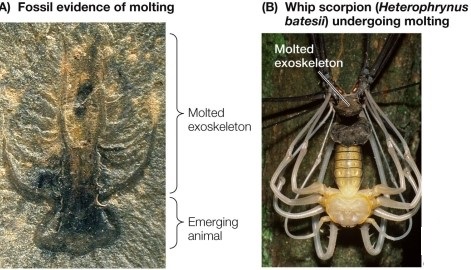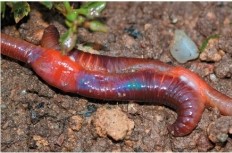A) many nematodes are microscopic and contribute to substrate composition.
B) parasitic nematodes have multiple stages, affecting multiple species.
C) nematode numbers contribute a huge proportion to overall biomass.
D) scavenging nematodes contribute to nutrient cycling.
E) nematodes provide a nutrient base for other animals.
Correct Answer

verified
Correct Answer
verified
Multiple Choice
Which of the following are not lophotrochozoans?
A) Nematodes
B) Mollusks
C) Bryozoans
D) Flatworms
E) Rotifers
Correct Answer

verified
Correct Answer
verified
Multiple Choice
Refer to the figure showing molting in a fossilized arthropod and in an extant arthropod.  Which of the following is false?
Which of the following is false?
A) Molting shown in the 500-million-year-old fossil arthropod supports the hypothesis that molting may have evolved only once.
B) The structure being shed is a cuticle.
C) The structure being shed is soft and easily pierced.
D) The new cuticle must expand and harden.
E) The process of molting is necessary for growth.
Correct Answer

verified
Correct Answer
verified
Multiple Choice
Which statement about flatworms is false?
A) Some are parasitic.
B) They possess a mouth but no anus.
C) They are diploblastic.
D) They possess some degree of cephalization.
E) Some possess complex life cycles.
Correct Answer

verified
Correct Answer
verified
Multiple Choice
Which of the following is not found in cephalopods?
A) A head with complex sense organs
B) A chambered shell in at least one genus
C) A branched foot that bears tentacles and a siphon
D) A modified mantle that functions as a lung
E) Use of tentacles to capture and subdue prey
Correct Answer

verified
Correct Answer
verified
Multiple Choice
An insect that exhibits gradual changes between its instars is said to undergo
A) incomplete metamorphosis.
B) fertilization.
C) dispersion.
D) ecdysis.
E) complete metamorphosis.
Correct Answer

verified
Correct Answer
verified
Multiple Choice
A wormlike body form enables animals to
A) escape predators.
B) exchange gases efficiently.
C) blend into their environments.
D) burrow efficiently through marine sediment or soil.
E) reproduce asexually.
Correct Answer

verified
Correct Answer
verified
Multiple Choice
Which statement(s) about chitons is true?
A) Their bodies are protected by variable numbers of overlapping calcareous plates.
B) They scrape algae, bryozoans, and other organisms from rocks with a radula.
C) They are gastropods.
D) They feed exclusively on other mollusks.
E) They move by means of an excurrent siphon.
Correct Answer

verified
Correct Answer
verified
Multiple Choice
For terrestrial arthropods, the advantage of a chitinous exoskeleton is that it
A) prevents the animal from dehydrating.
B) increases surface area for gas exchange.
C) increases the speed of movement.
D) provides a stored food supply.
E) increases the flexibility of movement.
Correct Answer

verified
Correct Answer
verified
Multiple Choice
The diversification of insects about 450 million years ago corresponded with
A) the appearance of the first land plants.
B) the extinction of the trilobites.
C) the extinction of dinosaurs.
D) changes in the CO2 concentration of the atmosphere.
E) movement of vertebrates onto land.
Correct Answer

verified
Correct Answer
verified
Multiple Choice
Based on their body _______, flatworms and rotifers were not thought to be closely related.However, _______ showed that they are a _______ group.
A) plans; the fossil record; monophyletic
B) cavities; gene sequencing; monophyletic
C) cavities; the fossil record; polyphyletic
D) plans; gene sequencing; monophyletic
E) cavities; gene sequencing; polyphyletic
Correct Answer

verified
Correct Answer
verified
Multiple Choice
Which group of organisms supplies the best evidence that elaborate parapodia are most suitable for respiration in a marine environment?
A) All annelids
B) Oligochaetes
C) Leeches
D) Polychaetes
E) Nematodes
Correct Answer

verified
Correct Answer
verified
Multiple Choice
Which of the following is not associated with the rotifers?
A) A pseudocoelom
B) A complete gut
C) Conspicuous feeding organs
D) Radial symmetry
E) Movement by beating cilia
Correct Answer

verified
Correct Answer
verified
Multiple Choice
Which of the following statements about spider webs and threads is false?
A) The webs can function as a home.
B) The threads are composed primarily of carbohydrates.
C) The threads are produced by modified abdominal appendages connected to internal secretory glands.
D) The webs function as a snare for catching prey.
E) The threads provide safety lines for climbing.
Correct Answer

verified
Correct Answer
verified
Multiple Choice
Which structures are specializations of the molluscan foot?
A) Siphon, shell, and radula
B) Arms and burrowing foot
C) Tentacles and reproductive structures
D) Arms, tentacles, and mantle cavity
E) Siphon and shell
Correct Answer

verified
Correct Answer
verified
Multiple Choice
Many flatworm species are parasitic.Which of the following is an adaptation of flatworms that is associated with a parasitic lifestyle?
A) A highly developed digestive system
B) A highly branched gastrovascular cavity
C) An organ system for oxygen transport
D) Absorption of nutrients through the body surface
E) Multiple pairs of appendages
Correct Answer

verified
Correct Answer
verified
Multiple Choice
Which respiratory structure distinguishes insects from other ecdysozoans?
A) Modified mantle
B) Gills
C) Gas exchange across the cuticle
D) Tracheae
E) Modified legs
Correct Answer

verified
Correct Answer
verified
Short Answer
The stage of the life cycle of Trichinella spiralis that has the greatest impact on humans is the _______.
Correct Answer

verified
Correct Answer
verified
Multiple Choice
Refer to the figure.  Gas exchange in this animal occurs through
Gas exchange in this animal occurs through
A) spiracles.
B) a thin, permeable body wall.
C) gills.
D) lungs.
E) a lophophore.
Correct Answer

verified
Correct Answer
verified
Multiple Choice
The most diverse group of insects (i.e., the group with the greatest number of species) consists of the
A) grasshoppers and crickets.
B) ants, bees, and wasps.
C) lice.
D) beetles.
E) thrips.
Correct Answer

verified
Correct Answer
verified
Showing 181 - 200 of 244
Related Exams